The Timing of David and Solomon's Reigns
by John P. Pratt
Reprinted from Meridian Magazine (12 Nov 2003)
©2003 by John P. Pratt. All rights Reserved.
Index,
Home
Sacred calendars provide precise dates for King David, his son Solomon, and the dedication of Solomon's temple, completing the chain of interlocking dates from Adam to Jesus, the son of David.
 |
Michelangelo's David.
King David ranks with the great patriarchs of the Old Testament in many ways. At the time of
Christ, a synonym for "Messiah" was "Son of David" (Mat. 12:23, 15:22, 20:30, 21:9) because
the promised Messiah was to be a descendant of David. Matthew begins his Gospel with a detailed
genealogy to prove that Jesus Christ fulfilled that requirement. Although not officially classed as a
prophet, David composed most of the book of Psalms, which contains some of the most inspired
revelations about Jesus Christ found anywhere in scripture. David is clearly a key figure in the Old
Testament.
Matthew also provides what appears to be a grand key in his genealogy of Jesus Christ. He points
out an important pattern which he knew would be meaningful to the Jewish audience he was trying
to convert. He noted that there were 14 generations from Abraham to David, 14 more until the
Babylonian captivity, and then 14 more to Christ (Mat. 1:17). Thus, he was indicating that God
has a plan, and that Christ was not only in the right family line, but that he filled the precise slot
reserved for the Messiah. But perhaps Matthew also provided for us a great clue as to how we
might find the last link to complete the chain of dates from Adam to Christ.
The first four articles in this series have shown how sacred calendars can be used to derive precise
dates for key religious events during the lives of Adam, Noah, Abraham and Moses,
respectively.[1] In former articles, precise dates were derived for the Savior's birth and ministry,
and the day that King Jeconiah was taken captive to Babylon.[2] Comparing this list of results to
Matthew's chain, we see that David is the missing link. That is, we have dates for Abraham,
Jeconiah, and Christ, so if we can determine the dates of King David's birth and reign, we will
have completed a list of anchor dates that span the entire Old Testament.
Let us begin the derivation of some important dates in the life of King David with his son, King
Solomon.
1. Solomon's Temple
Temples are links between heaven and earth, and often the dates of important events associated
with temples are clearly indicated on the Lord's sacred calendars. We saw in last month's article
on the Exodus that the date of the raising of the tabernacle was an important sacred day, and that
was only a portable tent version of the magnificent temple which would be erected centuries later
during the reign of King Solomon. That edifice was Israel's first temple, and it was accepted by
the Lord with fire from heaven consuming the offerings at its dedication (2 Chr. 7:1). Thus, we
might expect some dates associated with the temple to be prominent on the Lord's sacred
calendars.
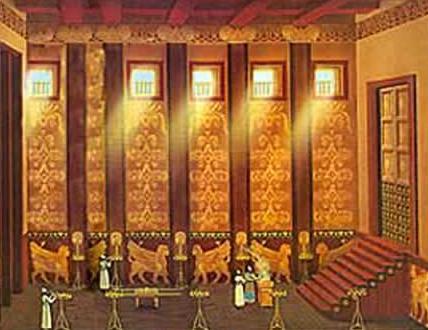 |
Solomon's Temple.
1.1 480th Year of the Exodus
The Old Testament provides one very precise link from the Exodus to the time of King David and
his son Solomon. It gives the very day on which the temple began to be built: the second day of
the second month of the fourth year of Solomon's reign, which was the 480th year from the
Exodus (1 Kings 6:1, 2 Chr. 3:2). That is the kind of detail that chronologists dream about. There
is only one such clue to tie David and Solomon back to the Exodus, but only one clue is needed if
it is indeed correct.
The approximate time of David is known to be about 1000 BC, as determined by counting back the
lengths of reigns of the kings from the known time of the deportation of King Jeconiah on Sat 10
Mar 597 BC.[3] Traditional chronologies indeed date the Exodus by counting back 479 years
from Solomon's supposed fourth year. For example, the edition of the Bible used by the LDS
Church before its new version was published listed the Exodus in 1491 BC, and Solomon
beginning to build the temple in 1012 BC. But many modern scholars have totally rejected the 480
years as symbolic or erroneous, and they date the Exodus to about 1260 BC.[4]
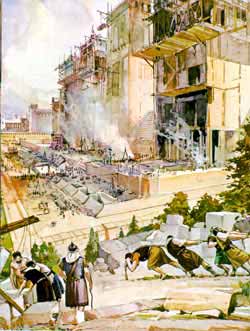 |
Construction of Solomon's Temple.
Is the Bible right or not about the date of King Solomon's temple? Now that we have the new tool
of the sacred calendars, we can check on at least some religious events to see if they fit into the
Lord's established pattern. And we have a precise date to check: the date indicated for beginning
Solomon's temple most likely corresponds to Tue 14 Apr 983 BC (2 Iyar, 479 years after
Exodus).
Looking at that date on the seven sacred calendars published so far, we find that it was not a special
day on any of the calendars. But that is not surprising even if it is correct for we have no precedent
to believe that the date on which a temple was begun should be a red-letter day on God's calendars.
In the only other case of a temple-like structure we have considered so far, the portable tabernacle
of Moses, it was the day on which it was first set up for use that the Lord's cloud settled on it. That would probably correspond to the dedication of Solomon's temple. The events which have been found significant so far are dates of the births and deaths of the great patriarchs and prophets, the dates of priesthood ordinances, and the dates of visits of angels and of the Lord himself.
The month of completion of the temple is also given, being the eighth month of Solomon's
eleventh year (1 Kings 6:38), which would be Oct-Nov, 976 BC. Searching that entire month also
yields nothing impressive on those calendars. Before passing judgment on the correctness of the
Biblical date, let us look at other related implied dates to see if any witnesses can be found to testify
of the correctness of this date. In fact, we have come to learn that if an event does indeed occur on
a significant calendar date, even then the Lord does not leave us wondering if it was just a chance
coincidence. In every case published so far in this series, there have been many mutually consistent
witnesses formed by a network of interlocking significant dates of related events. Thus, based on
previous discoveries, let us consider some of the more significant religious events of that time.
1.2 Temple Dedication
There was no doubt that the Lord accepted Solomon's temple because fire came down from heaven
and consumed the offerings. That seems like a much more promising date to be significant.
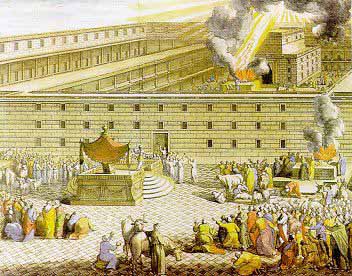 |
Solomon's Temple Dedication.
When was the temple dedicated? The Bible doesn't give the exact year in Solomon's reign, but it gives
enough clues to narrow it down to a few possible years. Let us review the order of events because
it appears that an important misunderstanding has occurred in many published chronologies.
Here are the relevant events in the order presented in the Bible:
- Solomon began building the temple in the fourth year of his reign (1 Kings 6:1, 2 Chr. 3:2).
- He finished the temple seven years later in his eleventh year (1 Kings 6:38).
- Solomon was building his own house for thirteen years (1 Kings 7:1).
- Solomon continued making furnishings for the temple until finally all was ready (1 Kings 7:15
51, 2 Chr. 5:1).
- The temple was dedicated at the feast of Tabernacles (1 Kings 8:2, 2 Chr. 5:3).
To me there is a natural interpretation of the sequence of those events: Solomon finished the temple
building in his eleventh year, his own home in his thirteenth year (which he presumably began at
his coronation), the temple furnishings were finished shortly thereafter and the temple dedicated.
Thus I would begin to look for the temple dedication beginning about the fourteenth year of his
reign.
The reason for presenting this detail is there is one (repeated) verse which has led to another
interpretation. An event is mentioned which occurred "at the end of twenty years, when Solomon
had built the two houses" (1 Kings 9:10-11, 2 Chr. 8:1). Because twenty happens to equal seven
plus thirteen, it has been assumed that Solomon first built and completed the house of the Lord,
then got the idea to build himself a home on which he spent thirteen more years, during which he
finished the furnishings for the temple.[5] That would mean that the temple wasn't dedicated until thirteen years after it was completed which seems unlikely.
In any case, using our new tool of sacred calendars, we can see if either of these interpretations
leads to the feast of Tabernacles being aligned with holy days on other sacred calendars. One very
plausible candidate presents itself: Sat 19 Sep 972 BC. That day was the Feast of Tabernacles, the
Autumn Equinox (Enoch), 1 Lord (Mercury), and 1 Water (SR). Being a holy day on four sacred
calendars is a good start, now let's look for related dates.
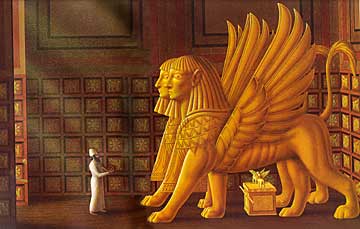 |
The Holy of Holies.
1.3 Dedication Finale
Tabernacles is usually a one week feast, with a solemn assembly on the eighth day (Lev. 23:34-36), but we are told that Solomon held the feast for two weeks that year (1 Kings 8:65, 2 Chr.
7:9). Why this change? Looking at the calendar shows that two weeks after Tabernacles was
another very special sacred day on the other calendars: Fri 2 Oct 972 BC pm* was the Feast of
Tabernacles on the Enoch calendar, 1 Creation (Mer), and 1 Wind (SR). Thus, if these dates are
correct, then by extending the feast, he celebrated the Feast on both the Hebrew and also the Enoch
calendar. This result suggests that Solomon was not usurping his authority as king
to change the sacred calendars, but instead was applying his famous wisdom to follow them.
 |
The high priest.
1.4 Priest Cycle Begins
There is another important detail which is not mentioned in the narrative at all, but which is crucial
to any date which is proposed. The 24 courses of priests who would take turns officiating weekly
in the temple would then begin to serve. We have seen that this rotation of service constitutes a
calendar, and the correlation of that calendar to ours is known.[6]. Thus, we would expect that the
day on which the first family began to serve (Jehoiarib) would be a significant date, for it would
begin a cycle that would hopefully continue unbroken until the destruction of the temple centuries
later. At the raising of the Tabernacle of Moses, the priests began to serve a week prior to the
event. Aligning with the priest cycle really narrows down the choice because the week of Jehoiarib
only occurs once every 24 weeks, only near Tabernacles every few years, and the cycle always
begins on a Saturday. An excellent date presents itself for the priests to have begun: Sat 5 Sep 972
BC, two weeks before the dedication, was Trumpets (Hebrew), Passover (Enoch Fixed), 0 Res
(Mer), 13 Eagle (SR), and most importantly, 1 Jehoiarib (Priest), the first day of the 168-day
cycle.
Thus, these three dates present a strong trilogy of testimonies that 972 BC was indeed the year of
the dedication of the temple, after Solomon had reigned fourteen years, and that the temple might
well have really been begun in the 480th year of the Exodus as claimed by the Bible.
2. King David
There are clues that important events in the life of King David might have been scheduled
according to the Venus cycle. First, he is tied to Christ who was the "Bright and Morning Star,"
symbolized by Venus. Secondly, he reigned for 40 years, and we have seen that 40 years is a
Venus/Mercury realignment cycle. Moreover, parents are often linked calendrically to their
children and his son Solomon also reigned for 40 years.
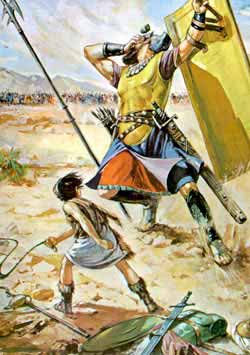 |
David Slays Goliath.
2.1 David's 40-Year Reign
The Bible states that David reigned for forty years (1 Kings 2:11, 1 Chr. 29:27). We have seen
that forty years may or may not refer to a Venus/Mercury realignment cycle of 14,599 days. The
big clue that the 40-year cycle is implied is on the rare occasions when both the beginning and end of
the cycle both occur on Hebrew holy days. Is there any such pair ending at the time of David's
death?
If the temple was begun in 983 BC in Solomon's fourth year of reign (1 Kings 6:1), then his first
year most likely began in 986 BC.[7] Checking alignments for that year yields a very promising
candidate for David's death: Mon 12 Jun 986 BC pm* which as 1 Tammuz (Hebrew, Summer
Equinox) and also 1 Creation (V) and 1 Lord (M).
Before proposing that day as David's death date, we need to check the day 14,599 days earlier
which began the 40-year cycle. If it also falls on a Hebrew holy day, then there is sufficient reason
to propose that David's reign really was tied to a 40-year Venus cycle. Sure enough, that day turns
out to be Thu 22 Jun 1026 BC which was the sacred fast day 17 Tammuz on the Hebrew calendar,
as well as being the expected 1 Cre (V) and 1 Lord (M).
Thus, let us accept as a working hypothesis that David began to reign over Judah on Thu 22 Jun
1026 BC and that he died on Mon 12 Jun 986 BC pm*, having had a reign of one 40-year
Venus/Mercury realignment cycle. Let us now investigate whether any supporting evidence can be
found.
2.2 David's Birth: July 4th
David was about thirty when he began to reign (2 Samuel 5:4), so we can look for a birth date,
which according to the pattern of other proposed birth dates in this series should occur both on a
Hebrew holy day, at least some other sacred calendars, and also on a date similar on some
calendars to his death date. Those requirements are so stringent to occur in a given year that if we
find such a date, it is highly likely to be correct. Moreover, in nearly every case so far, the birth
date is more impressive than the death date, and David's proposed death date is a sacred day on 4
calendars (also being 1 Condor on the Sacred Round).
Searching for a possible birth date for David produces an ideal candidate, a holy day on 6 of the 7
known sacred calendars. The day Sat 4 Jul 1057 BC was 17 Tammuz (H), 14 Sum (Enoch,
Summer Fast), 1 Res (V), 1 Bir (M), 1 Deer (SR), and 1 Jac (Easter on Priest). That Hebrew day
is known simply as the Fast of the Fourth Month, which the Lord says will become a day of
rejoicing some day (Zech. 8:19). That date ranks with the best birth dates found so far for the
prophets. It is identical on the Venus and Mercury calendars to Isaac's birthday. This date fits the
pattern so well of all the great prophets, as it should to be in Matthew's chain of key links to
Christ, that it confirms this whole set of dates as being correct, including the Biblical assertion that
the temple was built in the 480th year of the Exodus.
2.3 Birth of the United States
The United States of America was also born on July 4th, the date proposed for David's birth. Is
that of any significance? If so, there will also be at least another witness, according to what has
been discovered so far in the research. It turns out that Thu 4 Jul 1776 was also 17 Tammuz on
the Hebrew calendar as was David's birth, so it may not be by chance that the nation which
consistently sides with modern-day Israel was born on David's birthday.
So are all the fireworks
on the Fourth of July the fulfillment of the prophecy that 17 Tammuz will become a day of "joy
and gladness"? Probably not, partly because it is to be a day of rejoicing for the Jews and partly
because it is not celebrated annually on 17 Tammuz. But that prophecy may have begun to be fulfilled at the Nauvoo Temple dedication on 17 Tammuz.[8]
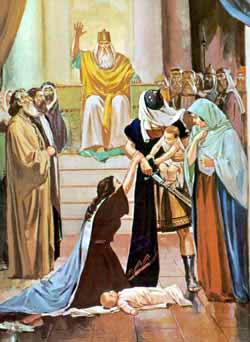 |
Solomon's Wisdom.
2.4 Solomon's Birth
If Solomon's birth date could be found, it might also testify of the correctness of
these proposed dates because we have seen that there is usually a calendrical link between parents
and their children. When was Solomon born? How old was he when he inherited the throne upon
the death of David? The Bible does not say, and checking other sources yields many confused
opinions. One standard Jewish interpretation is that he was crowned at age twelve, but that cannot
be because his son Rehoboam was born before David's death (1 Kings 15:10). The historian
Josephus put his age at death at 94 (Antiquities VIII.vii.8), which makes no sense because he was
born to Bathsheba during David's reign. So is there any hope of finding Solomon's birth date?
From the events of David's reign, he was most likely in his early twenties.
Fortunately one scholar lists Solomon's age as being 23 when he began to reign.[9] I don't know
his source, but now we have a way to check his result. In fact, a date can be found which is so
perfect that I feel confident enough to publish it: Tue 26 Jun 1009 BC was 1 Tam (H), 1 Res (V),
1 Pri (M) and 1 Monkey (SR). That is not only a sacred day on four calendars, it is the same day
as his father David's birth on the Venus calendar, and the same day as David's death on the
Hebrew calendar. This double link to David is rare enough to occur in the very year indicated as to
verify the correctness of that date.
3. Ezekiel's Witness
There is one last link to this time period which needs to be investigated. Hundreds of years after
David, and even after Nebuchadnezzar had deported all but the poor of the Kingdom of Judah, the
Lord had his prophet Ezekiel suffer a long ordeal to symbolize both Israel and Judah. Ezekiel was
among the captives in Babylon before the final destruction of Jerusalem.
3.1 430-day Ordeal
The Lord commanded Ezekiel to give captive Judah a very strange symbolic demonstration. First,
he set up a model battering ram to show how King Nebuchadnezzar of Babylon would lay siege to
Jerusalem (Ezek 4:1-3). Then the Lord told him to lay on his left side for 390 days to represent Israel,
and then to turn over and lay on his right side for 40 days to represent Judah, with each day
symbolizing a year (Ezek. 4:4-6). To show he was serious, the Lord commanded him to be bound
in those positions so that he wouldn't accidentally turn over prematurely (Ezek. 4:8). And if that
wasn't ordeal enough, the Lord also had him mix cow dung in with a recipe for bread, and kept
him on a strict ration of that bread and water, again to symbolize what Judah would experience
(Ezek. 4:9-17). At the end of the ordeal he was to shave his year's growth and divide it into three
parts to show the fate of those remaining. He was to burn one third, destroy one third with his
knife, and scatter one third to the wind. A very few shaven hairs were to be bound into captivity,
but the point was that this time Nebuchadnezzar would not be taking many captives as he did
before, but would show no mercy (Ezek. 5:1-17).[10]
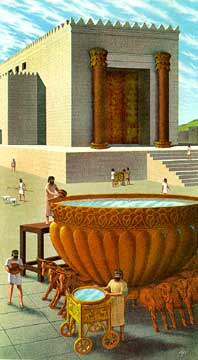 |
The Brazen Sea.
Let us focus on just the numerical part of this dramatic demonstration. A period of a total of 430
years is indicated: 390 for Israel followed by 40 for Judah. We have seen many 430-year intervals
in this series, always tied to the Venus cycle. Moreover, the 40 years for Judah is also a
Venus/Mercury realignment cycle. So if we knew what ending point of the count of years was
implied, then we could count back both 40 years and 430 years to look for possible significance.
3.2 Nebuchadnezzar's Siege
Ezekiel's demonstration of the coming siege of Jerusalem indicates that most likely the beginning
date of the siege would complete the 430 years. We have already seen that the Lord later
commanded Ezekiel to record the very day the siege began (Ezek. 24:1-2), which was Fri 11 Dec
589 BC, being 10 Teb (H), 1 Res (V), 1 Res (M).[11] That is an ideal place to begin counting
back a 40-year Venus/Mercury realignment, because both the Venus and Mercury calendars were
aligned on the sacred day 1 Resurrection and they would likely align again 40 years earlier.
3.3 Josiah's Cleansing
Counting back one 40-year Venus/Mercury alignment cycle of 14,599 days, brings us to Mon 21
Dec 629 BC pm*, which was 1 Teb (H, Begin Winter), 1 Res (V), 1 Res (M), and 1 Light (SR).
Those last three holy days are not a surprise because a Venus/Mercury realignment period is
expected to realign those days. But it is a bonus that the day was also 1 Tebeth, a holy day on the
Hebrew Calendar (Winter Solstice). So that is a witness that we are on the right track, and that this
truly is the day symbolized by Ezekiel. What might have happened at that time? It was most likely
when King Josiah began to purge all of the idolatry from Judah in his twelfth year (2 Chr.
34:3). If so, then it would be a good date to represent Judah as the Lord said. I have not yet
attempted a detailed chronology of all of the kings of Judah and Israel; at this point I am only trying
to establish the key anchor dates of religious history, so more research on this point is needed.
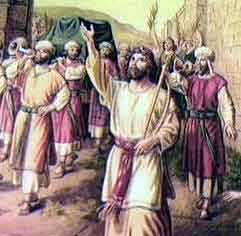 |
David Victorious.
3.4 David: King of Israel
Now let's count back another 390 years, for a total of a 430-year Venus realignment interval. That
brings us to Sat 16 Nov 1019 BC, 5 Kislev (Hebrew), 1 Res (V), 1 Light (SR). What event might
have occurred at that time that the Lord might have chosen to represent Israel? That day was seven
years and six months from the date proposed for the beginning of King David's reign over Judah.
Did anything significant happen at that time of David's reign?
The answer is a resounding yes! The record states that David "reigned over Judah seven years and
six months: and in Jerusalem he reigned thirty and three years over all Israel and Judah." (2 Sam.
5:5). So counting back a 430-year Venus cycle from the siege of Nebuchadnezzar brings us to the
very month indicated that David began to rule over all of Israel, that is, both the kingdoms of Judah
and Israel. Thus, it not only brings us to some significant date, it is also an ideal date to represent
Israel.
This is the final link in the chronological chain from Adam to Christ. That is, by counting forward
on the sacred calendars, and especially with the 430-year Venus cycle, we have been able to derive
precise dates for Adam, Enoch, Noah, Abraham, Isaac, Jacob, Moses, and then David. Also, we
have seen in previous articles that key dates in the life of Christ aligned with the Venus cycle, as
did the captivity of Jeconiah. The final link is now seen to be counting back one 430-year Venus
cycle from the siege of Jerusalem to David's being crowned King of all Israel. So we have
counted forward from Adam, and backward from Christ, and with the amazing precision of
agreeing with the exact scriptural month that David's reign over Israel began. Now we have more
than sufficient justification to accept all of these dates as correct.[12]
 |
Solomon's Temple.
3.5 Witness of Assyrian Chronology
After David became King of all Israel (in 1019 BC), many of the nearby nations made war against
him, and he prevailed. The Kingdom of Israel grew into a major power very quickly, having
conquered Palestine, Syria, Edom, Moab, Ammon, and Zobah (2 Sam. 8). Then those nations
sent for help from the "Syrians beyond the river," referring to Assyria, beyond the Euphrates (2
Sam. 10:15). That nation also suffered huge losses (40,000 infantrymen and 7,000 horsemen, 2
Sam. 10:18). The Septuagint (Greek) version of the Old Testament includes the name of the King
of Assyria at that time, "Chalamak" (II Kings 10:15). The historian Josephus explicitly states,
"they sent to Chalaman, the king of the Syrians, beyond the Euphrates, and hired him for an
auxiliary." (Antiquities VII.vi.3). He adds that after that battle, Assyria also became part of
David's empire.
This is an extremely important clue to chronology, because Assyria preserved a detailed listed of
kings and important events for centuries. The wonderful fact about these Assyrian records is that
they include some eclipses of the sun, which lock in those years with absolute certainty. It was
these records which led to the "Revised Chronology" listed in the LDS Bible Dictionary under
"Chronology" which starts at a date for Solomon's son Rehoboam in 953 BC. Nevertheless, the
Assyrian chronology is still being revised because several versions of their chronology have been
found which do not all agree, and more recently proposed dates for Rehoboam are 931 BC and
945 BC. The results being presented in this article agree well with the latter proposal because
Solomon's 40-year reign would have ended about that time.[13]
So the question is, is there an Assyrian king listed shortly after 1019 BC who could be identified
with Chalaman? The answer is that, based on the Assyrian chronology, Shalmaneser II is listed by
scholars as having reigned from 1030-1018 BC.[14] "Shalmaneser" is very close linguistically to "Chalaman." Thus, this independent record confirms that
the battle of David vs. Shalmaneser II most likely occurred in the summer of 1018 BC. This date
agrees precisely with the conclusions of at least one scholar who has researched this material in
detail.[15] Table 1 summarizes the dates proposed in this article and all the dates published so far are listed on all seven sacred calendars on my website.[16]
| Event | Date BC | Hebrew | S. Round | Venus | Mercury |
|---|
| David born | Sat 4 Jul 1057 | 17 Tam | 1 Deer | 1 Res | 1 Bir |
| King of Judah | Thu 22 Jun 1026 | 17 Tam | 1 Quake | 1 Cre | 1 Lrd |
| King of Israel | Sat 16 Nov 1019 | 5 Kis | 1 Light | 1 Res | — |
| Solomon born | Tue 26 Jun 1009 | 1 Tam | 1 Monkey | 1 Res | 1 Pri |
| David died | Mon 12 Jun 986 pm* | 1 Tam | 1 Condor | 1 Cre | 1 Lrd |
| Temple begun | Tue 14 Apr 983 | 2 Iyr | — | — | — |
| Temple done | Sun 30 Oct 976 | 12 Hes | — | — | — |
| Priests begin | Sat 5 Sep 972 | 1 Tis | 13 Eagle | — | 0 Res |
| Temple Dedication | Sat 19 Sep 972 | 15 Tis | 1 Water | — | 1 Lrd |
| Temple Finale | Fri 2 Oct 972 pm* | 29 Tis | 1 Wind | — | 1 Cre |
| Josiah's Purge | Mon 21 Dec 629 pm* | 1 Teb | 1 Light | 1 Res | 1 Res |
| Ezekiel begins | Thu 30 Jun 593 pm* | — | 1 Eagle | — | 1 Res |
| Ezekiel turns | Tue 25 Jul 592 pm* | — | 1 Serpent | — | 1 Qui |
| Ezekiel ends | Sat 2 Sep 592 | — | 1 Dragon | — | 1 Adt |
| Siege | Fri 11 Dec 589 | 10 Teb | 1 Flower | 1 Res | 1 Res |
Table 1. Summary of Dates presented in this article. Those for Ezekiel's ordeal are derived in footnote 12.
Now let us turn to one more witness of the entire series of dates.
4. The Witness of the Day-Year Pattern
There is another independent witness of many of the dates that have been presented in this entire
series of articles. It is the fact that the Lord says he counts years as he does days. That led me to
ask whether or not every year might be given a name in exactly the same manner as the days of the Hebrew year. That is, one year could be called 1 NISAN (capital letters referring to a year), and the next
year 2 NISAN, even as the days of the year are called 1 Nisan, followed by 2 Nisan. Thus, the
year named 1 NISAN would only occur about once in 365 years.[17]
The order in which the Hebrew days appears is fixed. Once a year is chosen to correspond with 1
NISAN, then all of the other years in history are determined, subject to a few other
constraints.[18] Let us choose the year of the Beginning of Mortality, when Adam and
Eve were driven from the Garden of Eden, to be the year 1 NISAN, corresponding to New Year's
Day. Having made that choice, look at the amazing results which come from merely following the
Lord's pattern, which is ultimately derived from the orbits of the earth and moon.
| Event | Year BC/AD | Year Name | Remarks |
|---|
| Beginning of Mortality | 4001 BC | 1 NISAN | New World Begins |
| Exodus | 1462 BC | 1 NISAN | Nation of Israel born |
| Change from Judges to Kings? | 1077 BC | 1 NISAN | New Government |
| Solomon's Temple Dedication | 972 BC | 17 TAMMUZ | Fast Day, also
David's Birthday |
| Captivity of Israel begins | 723 BC | 1 NISAN | Israel scattered |
| Captivity of Judah begins | 605 BC | 1 AB | Holy Day, Begin
counting 70 years |
| Captivity of King Jeconiah | 597 BC | 9 AB | Fast Day |
| Captivity Ends | 537 BC | 10 TISHRI | Atonement, 70th year |
| Greek Empire begins? | 370 BC | 1 NISAN | Philip of Macedonia |
| Savior born | 1 BC | 14 ADAR2 | Feast of "A Star"
(Esther) |
| Savior baptized | AD 29 | 14 NISAN | Passover |
| Savior begins Public Ministry | AD 30 | 15 NISAN | Passover |
| Nephites Destroyed | AD 384 | 15 NISAN | Passover |
| LDS Church born | AD 1830 | 14 NISAN | Passover |
| Restoration Completed | AD 1836 | 20 NISAN | Last Day Passover |
Table 2. Year Names. When years are sequentially named for Hebrew days, a pattern emerges showing many key religious events occurred in "holy years."
4.1 New Beginnings: 1 NISAN
From the table it is seen that the year 1 NISAN seems to mark beginnings of long eras in the
history of the Lord's people. The year of the Exodus falls exactly on the year named 1 NISAN
using this counting pattern. It is important to understand that the pattern indicates a precise year,
that is, once the pattern is chosen, it cannot be shifted by even one year. The next time the year 1
NISAN comes around is in the year 1077 BC. That is twenty years before the birth of David and
may somehow symbolize the end of the period of Judges and transition to kings. The next
occurrence of 1 NISAN occurs in the year 723 BC, the year of the deportation of Israel to
Assyria.[19] This date certainly was a "new beginning" for Israel, resulting in one portion
becoming "lost" and the many of the rest spreading out over Europe.[20] An interesting tie to the
Book of Mormon is that the Nephite civilization ended in AD 384, being 384 years after the birth
of Christ in 1 BC (Mormon 6:5). That year corresponded to 15 NISAN. Sometimes ages seem to
begin or end in the PASSOVER year and sometimes on the NEW YEAR; more research is
necessary to clarify this point.
4.2 Temple Dedication: 17 TAMMUZ
Now we see another witness of the correctness of the date of the dedication of the temple of
Solomon. According to this pattern, it occurred in the year 17 TAMMUZ, which corresponds to
the birthday of David, and to a holy year. Note that the birthdays of the prophets rarely occur in
these holy years. Those years seem to be more for scheduling events on a larger scale that affect
all of the Lord's people.
4.3 70-Year Captivity of Judah
The most amazing part of the table to me is the set of three related years of the 70-year captivity of
Judah. It began in the year 605 BC (1 AB) when Nebuchadnezzar took the first captives. Most of
Jerusalem was deported in 597 BC (9 AB), and the captivity ended in 538 BC (10 TISHRI) when
Cyrus conquered Babylon.[21] All three of those years are not only "holy years" but even the
particular days are meaningful. The day 1 Ab begins a month and hence is a good "beginning"
day, the day 9 Ab is the fast commemorating the destruction of the temple, and 10 Tishri is the day
of Atonement, representing making reconciliation with God. That all three of those key dates all
testify of the captivity is a strong witness of their accuracy and importance on the Lord's schedule.
It is also witness of the foreknowledge of God, as well as of his creating the huge clock of the
orbits of the earth and moon such that the Hebrew calendar pattern would work not only to
measure every day in history, but also that the identical pattern could also reckon every year of
history.
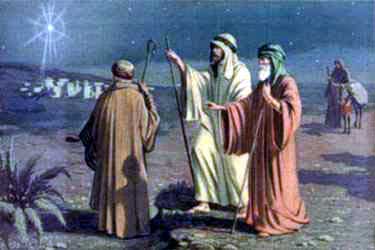 |
Savior Born at Feast of "A Star."
4.4 Jesus Christ: Meridian Passover
Of course if this day-year pattern is used for religious events, we would expect it to apply to
key events in the Savior's life. Here we are not disappointed. His birth occurred in the year 1 BC,
which corresponds on this calendar to the day 14 ADAR2, the Feast of Esther. As this research
began, it was not clear to me whether or not the Feast of Esther was an holiday on God's calendar,
or only on the Jewish calendar. After all, many holy days have been added, and I needed to prove
each one to see if God celebrates that holy day. It was when I discovered this correlation, and also
that the name Esther means "a star," that I became convinced that this holy day is real. I had
expected the Christ would be born in a Passover year, but what could be more appropriate that
having him born in the year of the Feast of a Star? Apparently the Star of Bethlehem itself was
prepared to join in the festivities.
An example of "meridian" symbolism is that when one reckons the Great Year of 385 years in
which Jesus was born from 1 TISHRI to 1 TISHRI, the year of his birth corresponds exactly to
the middle year. That is, it is year 193 of 385.
It was both the Baptism and Beginning of the Public Ministry of Christ which occurred in the
Passover year.[22] One full week of seven years corresponding to Passover week began at his
baptism, and he was crucified precisely at the midpoint of that week. Every detail of the timing of
the Savior's life seems to have taken into consideration at the Creation.
4.5 LDS "Passover Week"
Was the Hebrew calendar all fulfilled with the law of Moses at the Resurrection of Jesus Christ?
The Prophet Joseph Smith taught that what was fulfilled and done away with after the Resurrection
was only the detailed laws which were given to Moses, but not what was known from the days of
Adam (TPJS pp. 172-173). We have seen that the Hebrew calendar was used in the timing of
events from Adam on, so it should not be surprising to see that the Lord may still be using it in our
day.
The 7-year PASSOVER week of years only occurs about once every three or four centuries. It turns out
that the pattern indicates that the current Great Year began on Thu 20 Mar 1817, which was the
day 1 Nisan in the year 1 NISAN. The pattern described above suggests that the year 1817 should
mark a "new beginning" for the Lord's people.
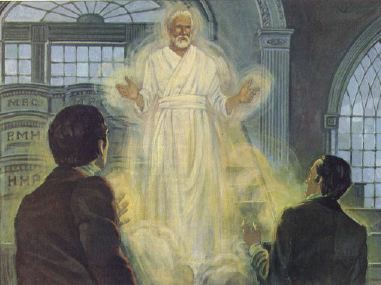 |
Elijah's Return Completed the Passover Week of Years.
The LDS Church was born on Thu 6 Apr 1830, near the beginning of the year 14 NISAN,
corresponding to PASSOVER. That in itself is a huge indication that the Lord is still using this
pattern. Remember, a PASSOVER year only occurs once in 365 years, on the average.
There is a second witness that this was not a chance coincidence. That year began a 7-year week,
which should end 6 years later with a "holy convocation," also called a "solemn assembly" on the
seventh and last day (year) of Passover (Lev. 23:8). Sure enough, on Easter Sunday of the year
1836, the Savior, Moses, Elias and Elijah all returned to the Kirtland Temple to bestow keys which
would complete the restoration of the Church of Jesus Christ. Thus, the 7-year PASSOVER
period encompassed key events of the restoration from beginning to end and definitely seems to be
part of the grand overall pattern.
5. Beyond Chance
It seems pointless to me to try to impress the reader by calculating the odds of one in
trillions of trillions that all of these alignments are totally beyond chance. Instead, I
will compare it to a hike I took last month to see some petrified trees. The hike was along a ravine
without a marked trail and I had no map. Walking up the rocky dry wash, I noticed a small pile of
about four rocks, like a little pillar, with a piece of petrified wood on top. I was still far from my
destination so I looked around, and there on the ground, at the bottom of the stream bed was a
petrified log embedded in the ground. Later, near the location where I hoped to find the remains of the
ancient forest, I saw another small pile of rocks, again with a piece of petrified wood on top.
Looking about, I saw no petrified wood, but I believed that these pillars had been created by
someone to indicate the way. So I left the ravine at that point and was delighted to find the
petrified trees nearby.
What are the chances that those piles of rocks just happened to be piled up by natural random
forces, such as rocks tumbling down the hill and landing on top of each other? And what is the
chance that the last such piece would be a flat piece of petrified wood? And that two such pillars
would assemble themselves? And that both would occur right at the location of large petrified
logs?
One doesn't have to be skilled in calculating mathematical probabilities to know that there is not a
chance in the world that those markers built themselves. It was not even necessary for me to know
that piles of rocks are often used to mark trails. The piece of petrified wood atop the pillar would
make it clear to anyone that someone was trying to communicate something about petrified wood to
future hikers. No one would think that those piles happened by chance.
The chances that all of the calendar alignments on holy days and in holy years presented in this
series of five articles happened by chance is about the same as those two piles just happening by
chance to be near the petrified logs, without having been stacked up by a person. And yet, the
pillars were very easy to explain once I believed that someone had prepared the way for me.
Accordingly, the only rational explanation known to me of all of these calendrical alignments is that
there was a Creator, who had a Master Plan from the beginning, who scheduled the key events in
religious history on his day-planner and DAY-planner, and then created a solar system to indicate
just what day it is.
6. Conclusion
The set of interlocking dates between David and Solomon testify that the Biblical account that
Solomon's temple was begun in the 480th year from the Exodus is precisely correct. It proposes a
very likely birth date for David which fits the pattern of having fallen on a Hebrew holy day and
also of Venus and Mercury, as was Jesus Christ, the "son of David." Ezekiel's
430 years (a Venus cycle), which indicates to the very month when King David began to rule over
Israel, witnesses of the last link in the chronological chain from Adam to Christ.
These five articles started with Adam and showed that there is a continuous set of linked anchor dates at the times of Adam, Noah, Abraham, Moses,
and David. The last two key anchor dates are at the time of the captivity of Jeconiah and of the
Resurrection of Jesus Christ. In addition to each of these sets of dates having the witnesses of
several rare alignments of multiple sacred calendars, there is also the over-arching witness of the
names of years counted by exactly the same pattern used for days. Calculating the
odds of so many alignments occurring by chance indicates that there is negligible probability of that
happening. Thus, an absolute framework of anchor dates throughout history has been established,
based on astronomical calculations as precise as those which calculate the dates of past observed
eclipses. All of these dates together testify in an irrefutable chorus that there is a Creator who has a
master schedule of key religious events which was known to the very day before the foundations
of the solar system were laid.
Notes
- Pratt, John P., "Venus and the Beginning of Mortality," Meridian Magazine (9 Jul 2003), "Astronomical Witnesses of the Great Flood," Meridian Magazine (13 Aug 2003), "Divine Calendars Testify of Abraham, Isaac, and Jacob," Meridian Magazine (11 Sep 2003), and "Exodus Date Testifies of Christ," Meridian Magazine (7 Oct 2003).
- Pratt, John P., "Passover: Was it Symbolic of His Coming?" Ensign (Jan. 1994), pp. 38-45, and "When Was Judah's 70-Year Babylonian Captivity?" Ensign (Oct 1998) pp. 64-65.
- See Pratt, "Captivity." This date is known precisely because it is recorded in the Babylonian
Chronicles. A great source on this subject is Edwin R. Thiele, The Mysterious Numbers of the
Hebrew Kings (Grand Rapids: Zondervan, 1983), who on p. 186 states, "The Babylonian tablet
states that Nebuchadnezzar ... besieged Jerusalem and captured the city on 2 Adar (Saturday, 16
March) 597." That date on the Julian calendar (which historians prefer) is identical to Sat 10 Mar
597 BC on our modern Gregorian calendar, used throughout my articles because of its greater
accuracy.
- Largey, Dennis L, ed., Book of Mormon Reference Companion (Salt Lake City: Deseret Book,
2003), in the article on "Chronology, Bible" by David R. Seely, p. 194. This wonderful new
encyclopedic volume contains a wealth of research and is an instant "must have" for anyone
wanting to keep abreast of current scriptural research. Seely gives the date of about 1260 BC as
commonly accepted by scholars for the Exodus. He is in turn quoting what is perhaps the most
accepted standard reference: Jack Finegan, Handbook of Biblical Chronology, Rev. ed. (Peabody,
Mass.: Henrickson, 1998), pp. 202-206, 245.
- This traditional interpretation is found in the Chronology section of the Dictionary in the current LDS Bible.
- Lefgren, John C. & Pratt, John P., "Dead Sea Scrolls May Solve Mystery,"
Meridian Magazine (12 Mar 2003).
- Even this seemingly simple calculation must be done with caution. There is evidence that some
kings counted their reigns from the fall and some from the spring. If he counted from the fall, then
it could have begun in 987 BC. Also, there is debate about whether the first year of the king was
when he actually was crowned, or if it began at the beginning of the following year. Fortunately
we can avoid many of these details because we have a new tool to determine actual death dates.
The death date found for David implies that the first year of Solomon was counted from when he
actually began to reign, whether or not regnal years were reckoned from fall or spring.
- Pratt, John P., "From Martyrdom to Celebration!" Meridian Magazine (June 6, 2002), section 6.
- Thiele listed his age as 23 as quoted on p. 261 of Faulstich, E.W., History, Harmony & the
Hebrew Kings (Spencer, Iowa: Chronology Books, 1986). The dates for David and Solomon's
reigns, as well as for the Exodus are within a year of what Faulstich calculated using very different
techniques. He researched the relationships to the Assyrian Eponym tables in detail and proposed
dates for all of the kings of both Israel and Judah.
- An important consequence for understanding the Book of Mormon about this demonstration is
that the Babylonian captivity, prophesied by Lehi (1 Nephi 1:13) was well underway at this time,
and only a few captives would be taken at the final destruction in 587 BC. Lehi probably left in
Apr 601 BC before the first destruction of Jerusalem in Nov 601 BC. See Pratt, John P., "Lehi's 600-Year Prophecy of the Birth of Christ," Meridian Magazine (31 Mar 2000).
- Pratt, John P., "Mortality," Section 2.2. This proposed date is one month earlier than that usually
given (see Thiele, p. 190) because the Hebrew calendar did not always coincide with the
Babylonian calendar, which most scholars use for their calculations. The Hebrew often began one
month ahead of the Babylonian, was we have seen in the case of the capture of Jeconiah on 10 Mar
597 BC, which was 1 Nisan (Hebrew) and 2 Adar (Babylonian). In 589 BC the Hebrew year
again began on 10 March, but the Babylonian a month later. That might explain why the Lord
actually told Ezekiel what the day was called, rather than simply to tell him to record the date,
because the day differed from the calendar where he was captive.
- Another witness comes from the dates on which the 430-day ordeal occurred. Ezekiel tells us
the precise day on which he began: one week (Ezek. 3:16) after he had had a vision about wheels
within wheels on 5 Tammuz of the fifth year of the captivity (Fri 24 Jun 593 BC, Ezek. 1:1-2).
The beginning day of the ordeal was Thu 30 Jun 593 BC pm*, which was 1 Eagle (SR) and 1 Res
(M). That day is indicated precisely in the Bible, so it is significant that it was a holy day on two
sacred calendars. The day 390 days after he began was Tue 25 Jul 592 BC pm*, being 1 Serpent
(SR) and the Midsummer Fast (Enoch). The 40th day thereafter, the last day of the ordeal, was
Sat 2 Sep 592 BC, being 1 Dragon (SR) and the Last Day of Burning on the Jubilee Fixed
Calendar. All three of those dates are significant: beginning on 1 Res (M) can imply that all of the
symbolized dates were 1 Res (V); and the actual burning of the temple most likely ended on Sun 24
July 587 BC, the day after 9 Ab (Midsummer Fast, Hebrew) and the Burning on the Jubilee
calendar. On that calendar the feast of Tabernacles often requires two weeks, which would explain
why Solomon extended that feast at the dedication of the temple. This is the first reference to the
Jubilee calendar in my articles, but in due time it will be published because it is yet another witness
of many of the dates proposed in this series.
- Thiele derives 931 BC, but admits that it is only one possible proposed solution. His goal was
not necessarily to get the one "true" answer, but to show that at least one answer consistent with the
Bible is possible. After reviewing Thiele's work, Faulstich proposed 945 BC for Rehoboam,
which agrees with my reckoning that Solomon's 40-year reign would have ended in 946-945 BC.
- The reference used by Finegan, Thiele and Faulstich is Daniel David Luckenbill, Ancient
Records of Assyria and Babylonia, Vol. II (New York: Greenwood Press, 1968), sec. 1196-98,
pp. 428-439, reprinted in Faulstich p. 265. The 1018 date represents a later revision by one year,
Faulstich, p. 274.
- Faulstich, p. 84, concludes that the "Battle of David vs. Shalmaneser II" occurred in 1018 BC, the year that Shalmaneser died.
- Pratt, John P., "Religious Chronology Summary," at http://www.johnpratt.com/items/docs/lds/dates.html.
- The Hebrew calendar has year lengths of 353, 354, 355, 383, 384 and 385 days, arranged so that years begin at the new moon and average to 365.25 days in length.
- One such constraint of the Perpetual Hebrew Calendar used in these articles is to choose which year corresponds to a "sabbath year." Remember that the Lord also counts years in weeks of seven years (Lev. 25:3-7), and hence every year can be thought of as named for the days of the week. Thus, a SUNDAY (again capitals refer to a year)
would be the first year of a the 7-year cycle, and SATURDAY would be the last day, like the days
of the week. My work agrees with the traditional Jewish interpretation, which is that Hebrew
years which are divisible by seven are sabbath years (SATURDAY). For example, the last Jewish
sabbath year began on Sat 30 Sep 2000, 1 Tishri (Hebrew), beginning the Hebrew year 5761,
which year is a multiple of seven (5761 = 823 x 7).
- The years 721 and 722 BC are often given, but both Thiele and Faulstich argue strongly that the reconciliation with the newly found ancient records demands that 723 BC is correct (Thiele, in his preface to his most recent third edition, p. 24).
- Pratt, John P., "Geological Evidence for the British Throne of David?" Meridian Magazine (2 June 2003).
- Pratt, John P., "Captivity" and
"Celestial Witnesses of the Meridian of Time," Meridian Magazine (10 Jul 2002), Section 1.
- Here, the details of the celebration are important. If the day is counted as beginning in the evening, then Passover is the day 15 Nisan, as on the Hebrew calendar. But if the day is counted as beginning at dawn, then Passover begins on the evening of 14 Nisan, and continues through the
evening of 15 Nisan. The distinction was made by referring to the holy day on the 15th as
Unleavened Bread, and to the 14th as Passover (Lev. 23:5-6). In my articles, to avoid confusion
and because I use almost exclusively the Hebrew calendar as beginning at 6 p.m., I simply
combine both into one, as do the Jews, calling it Passover. But using the day-year pattern from 1
Nisan in the spring is like counting days from dawn (i.e. spring is like dawn). So the "year" of
Passover technically begins on 1 Tishri in the autumn of the year 14 NISAN and continues until
the following 1 Tishri in the year 15 NISAN. Thus, in a sense, both 14 and 15 NISAN are
"Passover years."













